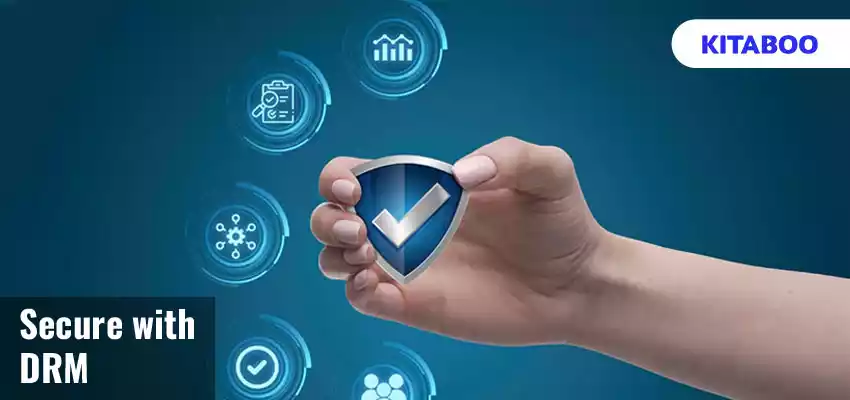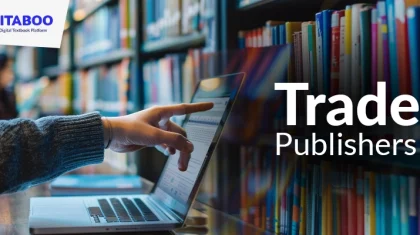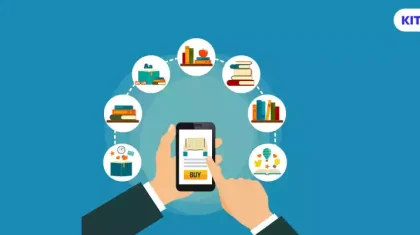
DRM Protection: Maximize the Benefits of Digital Publishing
Summarize this blog with your favorite AI:
Digital content has become increasingly popular over traditional media formats since the advent of the Internet.
While printed books continue to hold their ground, the preference for digital content has created a growing market for eBooks. This trend reveals various factors that encourage publishers to expand their digital book offerings.
While eBooks offer the advantages of global accessibility and higher sales, they also introduce the risk of unauthorized distribution. To mitigate these risks, publishers require an efficient tool that safeguards digital content; this is where DRM protection steps in. It not only safeguards your digital content but also maximizes the benefits of digital publishing in the long run.
In this post, we will explore the pivotal role of DRM protection, along with its significance in securing eBooks and practical insights into its implementation.
Let’s dive in!
Table of Contents:
II. Why is DRM Protection Important for eBooks?
III. How Does DRM Protection Secure eBooks?
- License Keys
- Digital Encryption
- Multi-Device Access Control
- User Permissions
- Identifiers: Watermarks and Metadata
- Time and Location Controls with DRM
IV. How to Secure Your eBooks Using DRM Protection?
V. Conclusion
What is DRM Protection?
Digital Rights Management, or DRM, supervises and controls the access and distribution of digital IP using technology. DRM protection leverages tools like encryption and digital watermarks to provide publishers with a layer of protection around their digital assets. This not only boosts revenue but also shields any confidential information in the content.
The primary goal of DRM protection is to prevent unauthorized copying, sharing, and distribution of digital content.
Digital textbook platforms like KITABOO come with advanced DRM protection features, ensuring that educational materials remain secure and are accessible only to authorized users. This way, the platform ensures that educational institutions and content creators have control over who can access and use their digital textbooks.
Why is DRM Protection Important for eBooks?
Here are some key reasons why DRM protection is considered vital for eBooks:
Economic Benefits
Online publishing of eBooks offers several benefits over traditional print publishing. At scale, they are more economical to publish than physical books. Additionally, the reflowable capability of eBooks allows users to engage with the content on a variety of electronic devices. Thus, there is a large market for eBooks that publishers can target.
However, digital piracy results in eBooks being distributed without purchase, thus impacting revenue. Ensuring DRM protection for eBooks safeguards the financial benefits of digital publishing.
Intellectual Property Safeguards
Without DRM protection, eBooks can be duplicated, modified, and redistributed with minimal hindrance. Furthermore, these eBooks may be tweaked and forwarded with altered writing credits. This reduces the control writers and publishers have over their intellectual property.
In addition to text, eBooks may contain visual and interactive elements to enhance the user experience.
Adding DRM protection helps secure all types of digital IPs against piracy. And it provides several intellectual property safeguards for writers, publishers, and content creators in the digital realm.
Creators can utilize features offered by digital textbook platforms like KITABOO to add audio and video to their interactive eBooks. These individual elements constitute intellectual property that could be replicated and reused, thereby hampering the exclusivity of the content.
Regulatory Compliance
E-books often include extra features for a better experience. Publishers need permission for these and might have sensitive data for authorized users. DRM makes sure publishers follow the rules, protecting them from issues related to compliance. It’s a way to confirm that creators stay on the right side of the law and avoid problems with unauthorized use.
How Does DRM Protection Secure eBooks?
DRM uses the following tools and technologies to protect your eBooks:
License Keys
DRM uses software to ensure that only users with a valid key can access your eBook. This key can also be used to validate the user’s copy online, which adds another layer of security. For highly sensitive documents, authentication keys can be generated in a time- or instance-bound manner.
Digital Encryption
DRM technology can encrypt digital text and supplementary content to safeguard it from illegitimate access. Encryption inherently boosts other DRM protection measures as well.
Multi-Device Access Control
Different users may wish to access the content of an eBook on different devices. Even a single user may prefer to read the eBook on multiple devices under different circumstances. Publishers and creators have various options to address this requirement.
- Allow users to access their purchased eBook on any number of devices. This is the most user-friendly option, but it makes the content more susceptible to digital piracy.
- Limit the access of the eBook to a single device. This may be achieved via software or hardware measures. For instance, the publisher could tie the content to a single eReader with the configuration necessary to read the eBook. This creates a highly restrictive user experience that may impact the publisher negatively.
- Use DRM to control the number of devices via which the user can engage with the content. With DRM protection, it is also feasible to limit the instances of the eBook to one while allowing multi-device access. This is the most balanced option for publishers.
User Permissions
DRM protection prevents unauthorized replication, modification, and distribution of your eBook by limiting the user privileges to read-only.
Identifiers: Watermarks and Metadata
DRM protection offers the use of embedded identifiers to establish ownership and trace the distribution of the digital IP. While these mechanisms do not directly block plagiarism attempts, they do help establish a trail of evidence. Instances of such identifiers are:
- Watermarks that are directly added to the content. In addition to text, they can also be integrated with audio and video files.
- Metadata is packaged along with the base content. These include details about the content creators and the purchaser.
Time and Location Controls with DRM
In some cases, access to digital IP needs to be restricted by time or geographical location. A few examples of such scenarios include the following:
- Time-Based Access: Access to the IP may be granted for a specific period of time. After the lapse of said duration, the license may need to be procured again.
- Geographical Restrictions: Publishers may not have the right to distribute their digital IP globally. Access to the content would be allowed for a specified geographical region.
By incorporating DRM protection, digital content providers can effectively control access based on factors such as time and location, tailoring permissions to align with licensing agreements and geographical distribution rights. This not only safeguards the content but also helps creators and publishers manage and monetize their intellectual property in a controlled and compliant manner.
Guide:
Know How to Create an Interactive eBook
How to Secure Your eBooks Using DRM Protection?
The approach to adding DRM protection to your eBooks will depend on your publishing method.
- If your publishing platform does not include DRM, procure standalone DRM software. Once your eBook is created, use the DRM software to secure your eBook.
- Alternatively, select a publishing platform like KITABOO, which has DRM built in. When your eBook is ready for publishing, upload it to the platform with DRM enabled.
Before distributing your eBook, test the DRM protection to ensure it functions as intended. Verify that access restrictions and other settings are working correctly. This will help you ensure the effectiveness of your DRM protection in the long run.
Conclusion
DRM protection secures your eBooks against piracy and preserves the benefits of digital publishing. It also aids regulatory compliance by preventing unauthorized access to sensitive information. Therefore, including DRM protection will streamline the publishing workflow and expedite content creation.
Digital textbook platforms like KITABOO offer DRM as an in-built feature to make content creation safe and efficient for publishers. With the help of this platform, publishers can ensure the integrity of their content while facilitating a secure and compliant publishing process.
Want to learn more? Connect with us now!
Related Reads:
- DRM Protection: A Shield Against Unauthorized eBook Access
- How Does DRM Protection Help in Safeguarding Your Digital Content?
- Digital Rights Management Software: Protect Your Content
- Digital Rights Management Software: Protect Content & Drive Revenues
- K12 Publishers
- Associations & Societies
- Trade Publishers
- Training Companies
- Content Aggregators
Discover how a mobile-first training platform can help your organization.
KITABOO is a cloud-based platform to create, deliver & track mobile-first interactive training content.



